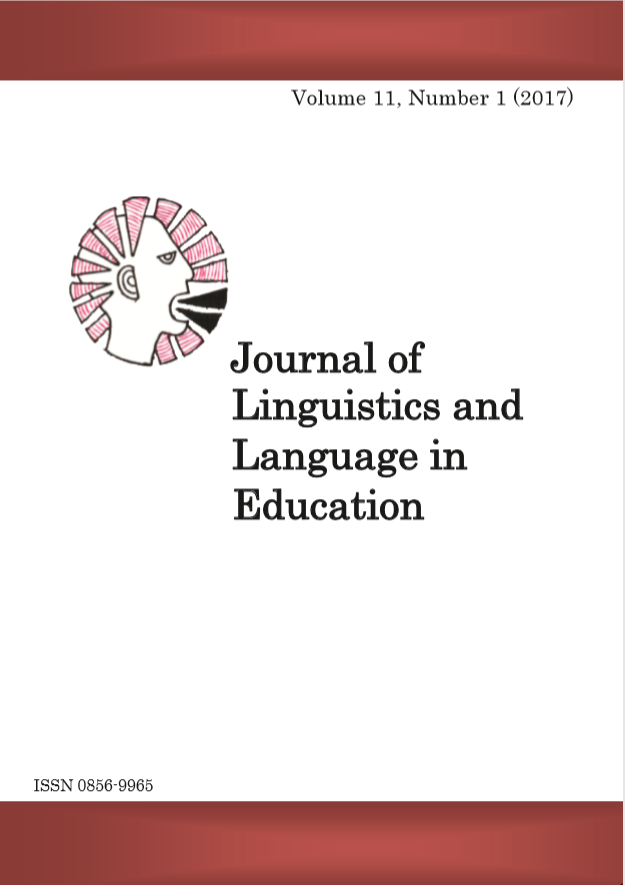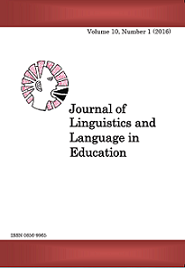An Appraisal of the Effectiveness of Repetitions used in HIV and AIDS Posters
Abstract
Abstract :Public communication of HIV and AIDS matters is challenging, given the sensitivity and complexity of the topic, hence the employment of various linguistic strategies. This study appraises the effectiveness of repetitions employed as lexical devices in ten PSI Zimbabwe HIV and AIDS posters. These posters were selected using a purposive sampling technique, based on observed manifestations of linguistic redundancy. The study was guided by Halliday and Hasan ' s (1976) Cohesive model for conceptualising texts. Data was analysed using the Content Analysis method, through establishing the categories of repetitions used and their frequencies, followed by presenting numerical data in the form of tables. The results indicated that there was overuse of repetitions in HIV and AIDS posters, predominantly employing stylistic non-conceptual repetitions, as opposed to conceptual ones, promoting unwarranted redundancy and poor readability. Recommended is the minimal use of repetitions, particularly the non-conceptual ones, in order to eliminate redundancy and achieve effective communication. Key words: HIV and AIDS posters, repetition, appraisal, cohesion, effectivenessReferences
References
Aitchison, J. (1994). Say it again, Sam. In A. Fischer (ed.). Swiss
Papers in English Language and Literature Repetition.
Tuebingen: Gunter Narr Verlag: 15 €“34.
Baldick, C. (2001). The Concise Oxford Dictionary of Literary Terms.
Oxford: Oxford University Press.
Bazzanella, C. (2011). Redundancy, Repetition, and Intensity in
Discourse. Language Sciences, 33(2): 243 €“254.
Berg, B. (1998). Qualitative Research Methods for the Social
Sciences. Boston: Ally and Bacon.
Biber, D., Johansson, S., Leech, G., Conrad, S., & Finegan, E. (1999).
Longman Grammar of Spoken and Written English. London:
Longman.
Brody, J. (1994). Multiple Repetitions in Tjal ' ab Conversations.In B.
Johnstone (ed.). Repetition in Discourse: Interdisciplinary
Perspectives. New Jersey: Ablex Publishing Corporation: 31 €“
Brody, J. (1986). Repetition as a Rhetorical and Conversational
Device in Tojolabal, Mayan. International Journal of
American Linguistics, 52(3): 255 €“274.
Brown, G. & Yule, G. (1983). Discourse Analysis. Cambridge:
Cambridge University Press.
Brown, P. &Levinson, S. C. (1987). Politeness. Some Universals in
Language Use. Cambridge: Cambridge University Press.
Burns, N. & Grove, S. K. (2001). The Practice of Nursing Research.
Philadelphia: Saunders.
Coates, J. (1996). Women Talk. Oxford: Blackwell Publishers.
Cuddon, J. A. & Preston, C. E. (1999). The Penguin Dictionary of
Literary Terms and Literary Theory. London: Penguin.
Clemenciana Mukenge |23
Curl, T. S. (2002). The Phonetics of Sequence Organization: An
Investigation of Lexical Repetition in Other-initiated Repair
Sequences in American English. PhD Thesis, University of
Colorado.
Curl, T. S., Local, J. & Walker, G. (2006). Repetition and the
Prosodypragmatics Interface. Journal of Pragmatics, 38(10):
€“1751.
Cushing, S. (1994). Air Cal Three Thirty-Six, Go Around Three
Thirty-Six, Go Around: Linguistic Repetition in Air Ground
Communication. In B. Johnstone (ed.).Repetition in
Discourse.New Jersey: Ablex Publishing Corporation: 53 €“65.
Deacon, D. H., Pickering, M., Golding, P. & Murdock, G.
(1999).Researching Communications. London: Arnold.
Fowler, C. A. (1988). Differential Shortening of Repeated Context
Words Produced in Various Communicative Contexts.
Language and Speech, 31(2): 307 €“319.
Halliday, M. A. K., &Hasan, R. (1976). Cohesion in English. New
York: Longman.
Hansen, A., Cottle, S., Negrine, R. & Newbold, C. (1998). Mass
communication Research Methods. London: Palgrave.
Holmes, J. & Stubbe, M. (2003). Power and Politeness in the
Workplace. Harlow: Pearson Education.
Hsia, H. J. (1977). Redundancy: It the Lost Key to Better
Communication? AV Communication Review, 25(1): 63 €“85.
Hsieh, F. (2011). Repetition in Social Interaction: A Case Study on
Mandarin Conversations. International Journal on Asian
Language Processing, 19(4):153 €“168.
Jackson, R. C. (2016). The Pragmatics of Repetition, Emphasis and
Intensification.PhD Thesis, University of Salford, UK.
Johnstone, B. (1994). Repetition inDiscourse: ADialogue. In B.
Johnstone (ed.). Repetition in Discourse: Interdisciplinary
Perspectives. New Jersey: Ablex Publishing Corporation
Advances: 2 €“23.
Jucker, A. H. (1994). Irrelevant Repetitions: A Challenge to
Relevance Theory. In A. Fischer (ed.). Swiss Papers in English
Language and Literature Repetition. Tuebingen: Gunter Narr
Verlag: 47 €“60.
Kemertelidze, N. & Manjevidze, T. (2013). Stylistic Repetition, Its
Peculiarities and Types in Modern English. European
Scientific Journal. 2013 Special Edition.
Krippendorff, K. (2004). Content Analysis: An Introduction to its
Methodology. California: Sage Publication, Inc.
| Effectiveness of Repetitions used in HIV and AIDS Posters
Leanne, S. (2009). Say it Like Obama: The Power of Speaking with
Purpose and Vision. New York: RR Donnelley.
Leech, G. N. & Short, M. H. (1981). Style in Fiction: A Linguistic
Introduction to English Fictional Prose. London: Longman.
McArthur, T. (1992). The Oxford Companion to the English
Language. New York: Oxford University Press.
Merritt, M. (1994). Repetition in Situated Discourse: Exploring its
Forms and Functions. In B. Johnstone (ed.). Repetition in
Discourse Interdisciplinary Perspectives. New Jersey:
AblexPublishing Corporation Advances: 23 €“36.
Mlambo, M. (2009) Using the Type-Token ration in the Study of
Repetition Patterns in the Second Language Lexical
Development of Learners from Two Different English
Language Backgrounds. Zimbabwe Journal of Educational
Research, 21(3): 340 €“357.
Murata, K. (1995). Repetitions: A Cross-Cultural Study. World
English, 14: 343 €“356.
Norrick, N. R. (1987). Functions of Repetition in Conversation. Text,
(3): 245 €“264.
Norrick, N. R. (1994) Repetition as a Conversational Joking Strategy.
In B. Johnstone (ed.).Repetition in Discourse Interdisciplinary
Perspectives. New Jersey: Ablex Publishing Corporation: 15 €“
Osborn, S. (2006) Reconsidering Elizabeth Bowen. Modern Fiction
Studies, 52(1): 187 €“197.
Patton, M. Q. (2001). Qualitative Research and Evaluation Methods.
California: Sage Publications, Incorporated.
Persson, G. (1974). Repetition in English. Uppsala: University of
Uppsala.
Preminger, A. &Brogan, T. V.F. (eds.). (1993). The New Princeton
Encyclopedia of Poetry and Poetics. Princeton: Princeton
University Press.
Reynolds, D.W. (1995). Repetition in Non-Native Speaker Writing.
Studies in Second Language Acquisition,17(2): 185 €“209.
SAFAIDS (2009) HIV and AIDS Documentation and Communication
Skills. A Focus on Best Practices. A Course Guidebook.
Schatzman, L. &Strauss, A. L., (1973) Field Research: Strategies for
a Natural Sociology. Englewood: Prentice-Hall.
Short, M. (2007) Style in Fiction. London: Longman.
Simpson, J. M. (1994). Regularized Intonation in Conversational
Repetition. In B. Johnstone (ed.). Repetition in Discourse:
Interdisciplinary Perspectives. New Jersey: Ablex Publishing
Corporation: 41 €“49.
Clemenciana Mukenge |25
Smith, F. (1988) Understanding Reading. New Jersey: Erlbaum.
Streubert, H. G. & Carpenter, D. R. (1999). Qualitative Research in
Nursing. Philadelphia: Lippincott.
Tannen, D. (1987). Repetition in Conversation as Spontaneous
Formulaicity. Text, 7(3): 215 €“243.
Tannen, D. (1989).Talking Voices: Repetition, Dialogue, and Imagery
in Conversational Discourse. Cambridge: Cambridge
University Press.
Tannen, D. (2007).Talking Voices: Repetition, Dialogue, and Imagery
in Conversational Discourse. Cambridge: Cambridge
University Press.
Thompson, G. (2004). Introducing Functional Grammar. London:
Hodder Education.
Tyler, A. (1994). The Role of Repetition in Perceptions of Discourse
Coherence. Journal of Pragmatics, 21(2): 671 €“688.
Wilson, D.&Sperber, D. (2002). Relevance Theory. UCL Working
Papers in Linguistics, 14: 249 €“287.
Wimmer, R. D. & Dominick, J. R. (1997). Mass Media Research: An
Introduction. London: Wadsworth.
Downloads
Published
Issue
Section
License
Copyright © by Department of Foreign Languages and Linguistics, University of Dar es Salaam
All rights reserved. No part of this publication may be reproduced or transmitted in any form or by any means, electronic or mechanical, including photocopying, recording, or any information storage or retrieval system, without permission in writing from the publisher, except for short extracts in fair dealing, for research or private study, critical scholarly review or discourse with an acknowledgement.



